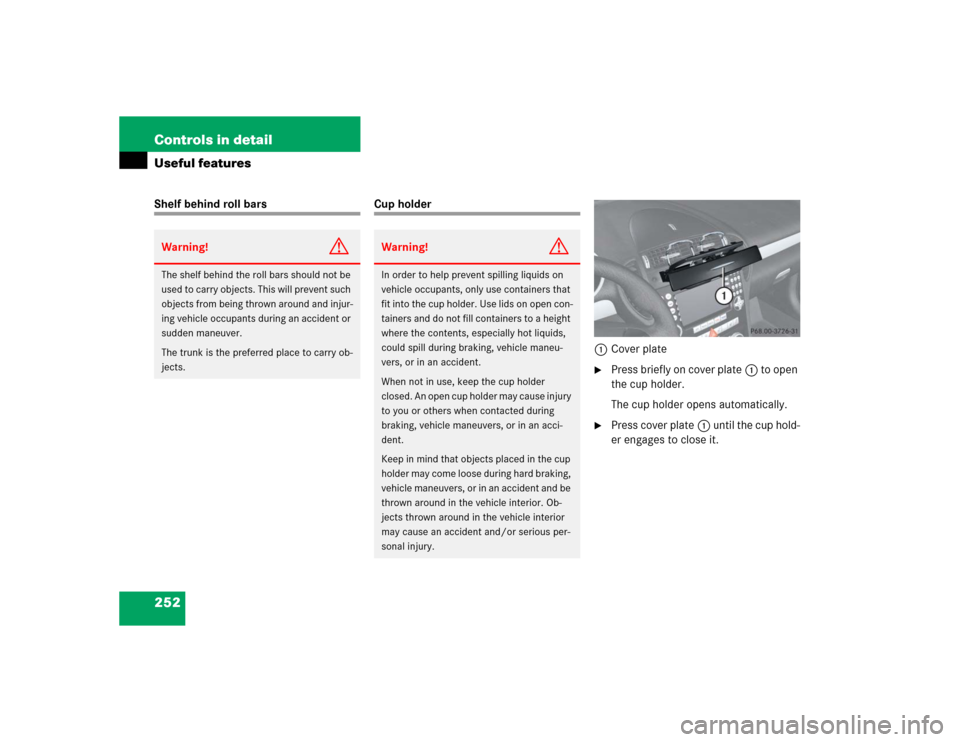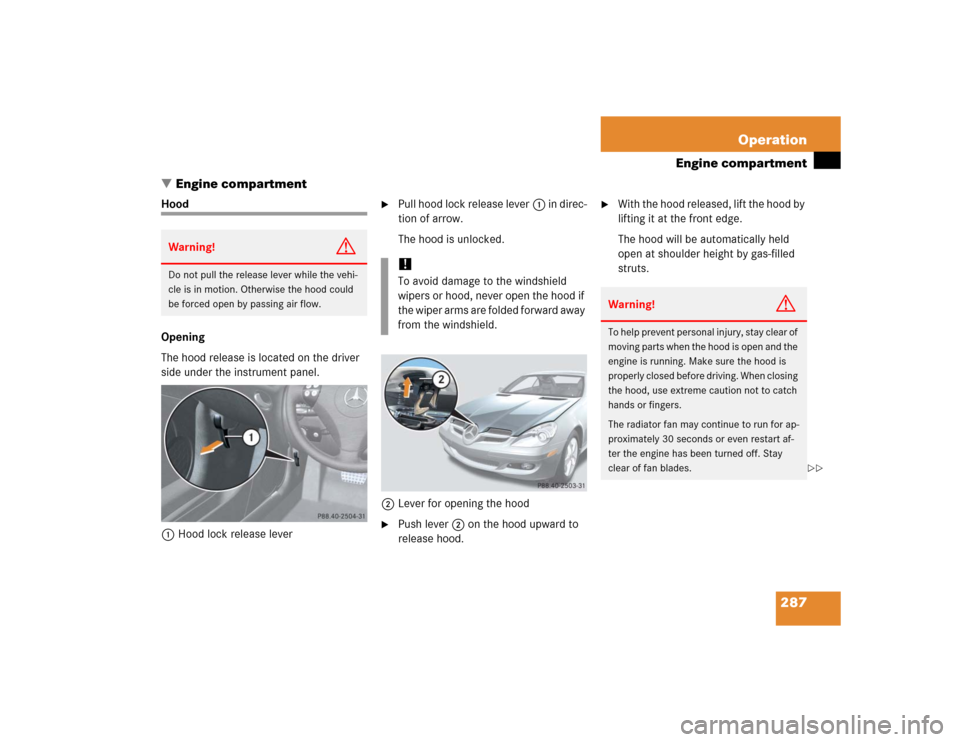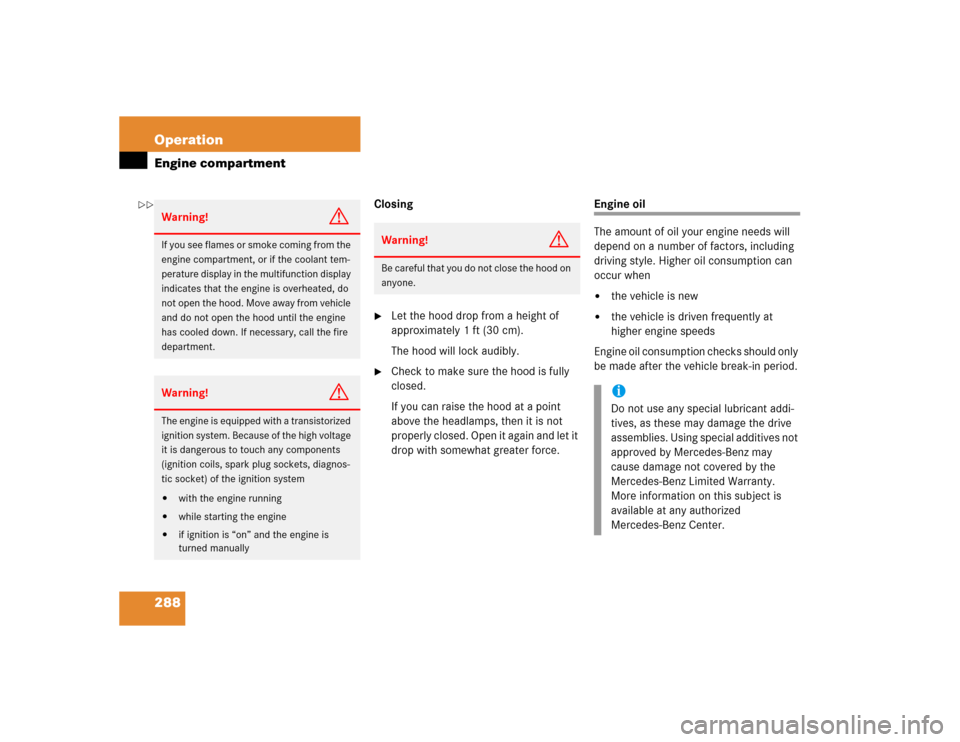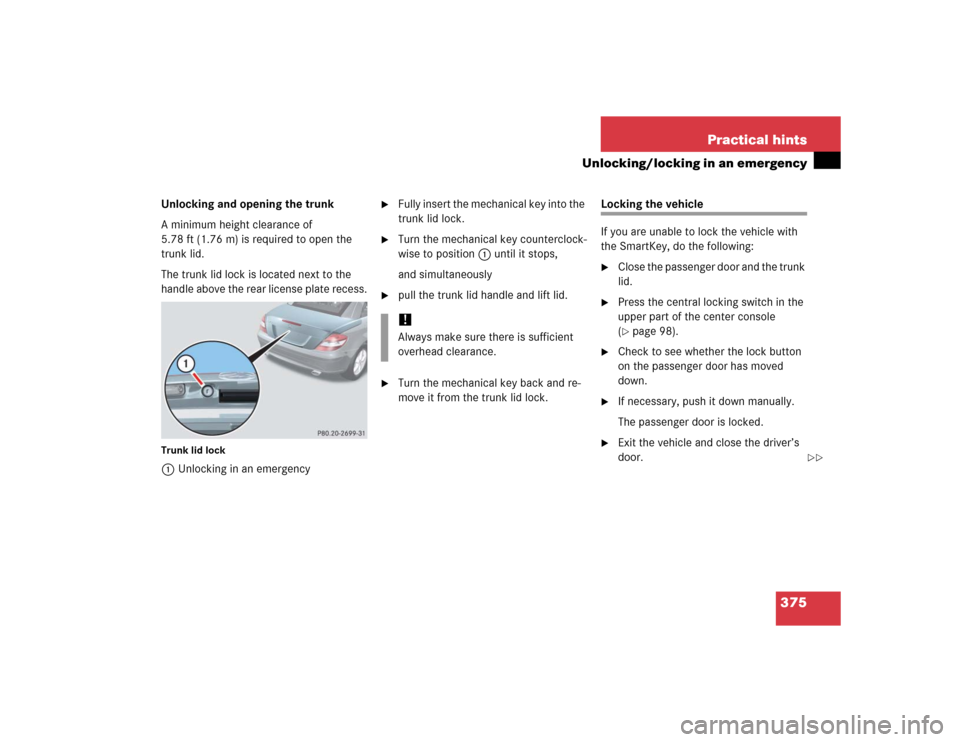Page 252 of 464

252 Controls in detailUseful featuresShelf behind roll bars
Cup holder
1Cover plate
�
Press briefly on cover plate1 to open
the cup holder.
The cup holder opens automatically.
�
Press cover plate1 until the cup hold-
er engages to close it.
Warning!
G
The shelf behind the roll bars should not be
used to carry objects. This will prevent such
objects from being thrown around and injur-
ing vehicle occupants during an accident or
sudden maneuver.
The trunk is the preferred place to carry ob-
jects.
Warning!
G
In order to help prevent spilling liquids on
vehicle occupants, only use containers that
fit into the cup holder. Use lids on open con-
tainers and do not fill containers to a height
where the contents, especially hot liquids,
could spill during braking, vehicle maneu-
vers, or in an accident.
When not in use, keep the cup holder
closed. An open cup holder may cause injury
to you or others when contacted during
braking, vehicle maneuvers, or in an acci-
dent.
Keep in mind that objects placed in the cup
holder may come loose during hard braking,
vehicle maneuvers, or in an accident and be
thrown around in the vehicle interior. Ob-
jects thrown around in the vehicle interior
may cause an accident and/or serious per-
sonal injury.
Page 287 of 464

287 Operation
Engine compartment
�Engine compartment
Hood
Opening
The hood release is located on the driver
side under the instrument panel.
1Hood lock release lever
�
Pull hood lock release lever1 in direc-
tion of arrow.
The hood is unlocked.
2Lever for opening the hood
�
Push lever2 on the hood upward to
release hood.
�
With the hood released, lift the hood by
lifting it at the front edge.
The hood will be automatically held
open at shoulder height by gas-filled
struts.
Warning!
G
Do not pull the release lever while the vehi-
cle is in motion. Otherwise the hood could
be forced open by passing air flow.
!To avoid damage to the windshield
wipers or hood, never open the hood if
the wiper arms are folded forward away
from the windshield.
Warning!
G
To help prevent personal injury, stay clear of
moving parts when the hood is open and the
engine is running. Make sure the hood is
properly closed before driving. When closing
the hood, use extreme caution not to catch
hands or fingers.
The radiator fan may continue to run for ap-
proximately 30 seconds or even restart af-
ter the engine has been turned off. Stay
clear of fan blades.
��
Page 288 of 464

288 OperationEngine compartment
Closing�
Let the hood drop from a height of
approximately 1 ft (30 cm).
The hood will lock audibly.
�
Check to make sure the hood is fully
closed.
If you can raise the hood at a point
above the headlamps, then it is not
properly closed. Open it again and let it
drop with somewhat greater force.
Engine oil
The amount of oil your engine needs will
depend on a number of factors, including
driving style. Higher oil consumption can
occur when�
the vehicle is new
�
the vehicle is driven frequently at
higher engine speeds
Engine oil consumption checks should only
be made after the vehicle break-in period.
Warning!
G
If you see flames or smoke coming from the
engine compartment, or if the coolant tem-
perature display in the multifunction display
indicates that the engine is overheated, do
not open the hood. Move away from vehicle
and do not open the hood until the engine
has cooled down. If necessary, call the fire
department.Warning!
G
The engine is equipped with a transistorized
ignition system. Because of the high voltage
it is dangerous to touch any components
(ignition coils, spark plug sockets, diagnos-
tic socket) of the ignition system�
with the engine running
�
while starting the engine
�
if ignition is “on” and the engine is
turned manually
Warning!
G
Be careful that you do not close the hood on
anyone.
iDo not use any special lubricant addi-
tives, as these may damage the drive
assemblies. Using special additives not
approved by Mercedes-Benz may
cause damage not covered by the
Mercedes-Benz Limited Warranty.
More information on this subject is
available at any authorized
Mercedes-Benz Center.
��
Page 314 of 464

314 OperationTires and wheelsGeneral:
Depending on the design standards used,
the tire size molded into the sidewall may
have no letter or a letter preceding the tire
size designation.
No letter preceding the size designation
(as illustrated above): Passenger car tire
based on European design standards.
Letter “P” preceding the size designation:
Passenger car tire based on U.S. design
standards.
Letter “LT” preceding the size designation:
Light Truck tire based on U.S. design
standards.
Letter “T” preceding the size designation:
Temporary spare tires which are high
pressure compact spares designed for
temporary emergency use only. Tire width
The tire width1 (
�page 313) indicates
the nominal tire width in mm.
Aspect ratio
The aspect ratio2 (�page 313) is the
dimensional relationship between tire
section height and section width and is
expressed in percentage. The aspect ratio
is arrived at by dividing section height by
section width.
Tire code
The tire code3 (
�page 313) indicates
the tire construction type. The “R” stands
for radial tire type. Letter “D” means diag-
onal or bias ply construction; letter “B”
means belted-bias ply construction.
At the tire manufacturer’s option, any tire
with a speed capability above 149 mph
(240 km/h) can include a “ZR” in the size
designation (for example: 245/40 ZR 18).
For additional information, see “Tire speed
rating” (
�page 315).Rim diameter
The rim diameter4 (
�page 313) is the
diameter of the bead seat, not the
diameter of the rim edge. Rim diameter is
indicated in inches (in).
Tire load rating
The tire load rating5 (�page 313) is a
numerical code associated with the
maximum load a tire can support.
For example, a load rating of 91 corre-
sponds to a maximum load of 1 356 lbs
(615 kg) the tire is designed to support.
See also “Maximum tire load”
(
�page 319) where the maximum load as-
sociated with the load index is indicated in
kilograms and lbs.
Page 323 of 464

323 Operation
Tires and wheels
Tire and loading terminology
Accessory weight
The combined weight (in excess of those
standard items which may be replaced) of
automatic transmission, power steering,
power brakes, power windows, power
seats, radio, and heater, to the extent that
these items are available as
factory-installed equipment (whether
installed or not).
Air pressure
The amount of air inside the tire pressing
outward on each square inch of the tire.
Air pressure is expressed in pounds per
square inch (psi), or kilopascal (kPa) or
bars.
Aspect ratio
Dimensional relationship between tire
section height and section width
expressed in percentage.Bar
Another metric unit for air pressure. There
are 14.5038 pounds per square inch (psi)
to 1 bar; there are 100 kilopascals (kPa)
to 1 bar.
Bead
The tire bead contains steel wires wrapped
by steel cords that hold the tire onto the
rim.
Cold tire inflation pressure
Tire inflation pressure when your vehicle
has been sitting for at least three hours or
driven no more than one mile (1.6 km).
Curb weight
The weight of a motor vehicle with stan-
dard equipment including the maximum
capacity of fuel, oil, and coolant, and, if so
equipped, air conditioning and additional
optional equipment, but without passen-
gers and cargo.DOT (D
epartment o
f T
ransportation)
A tire branding symbol which denotes the
tire meets requirements of the
U.S. Department of Transportation.
GAWR (G
ross A
xle W
eight R
ating)
The GAWR is the maximum permissible
axle weight. The gross vehicle weight on
each axle must never exceed the GAWR for
the front and rear axle indicated on the
certification label located on the driver’s
door B-pillar.
GVW (G
ross V
ehicle W
eight)
The GVW comprises the weight of the
vehicle including fuel, tools, spare wheel,
installed accessories, passengers and
cargo and, if applicable, trailer tongue
load. The GWV must never exceed the
GWVR indicated on the certification label
located on the driver’s door B-pillar.
Page 375 of 464

375 Practical hints
Unlocking/locking in an emergency
Unlocking and opening the trunk
A minimum height clearance of
5.78 ft (1.76 m) is required to open the
trunk lid.
The trunk lid lock is located next to the
handle above the rear license plate recess.Trunk lid lock1Unlocking in an emergency
�
Fully insert the mechanical key into the
trunk lid lock.
�
Turn the mechanical key counterclock-
wise to position1 until it stops,
and simultaneously
�
pull the trunk lid handle and lift lid.
�
Turn the mechanical key back and re-
move it from the trunk lid lock.
Locking the vehicle
If you are unable to lock the vehicle with
the SmartKey, do the following:�
Close the passenger door and the trunk
lid.
�
Press the central locking switch in the
upper part of the center console
(�page 98).
�
Check to see whether the lock button
on the passenger door has moved
down.
�
If necessary, push it down manually.
The passenger door is locked.
�
Exit the vehicle and close the driver’s
door.
!Always make sure there is sufficient
overhead clearance.
��
Page 420 of 464
420 Technical dataMain DimensionsModel
SLK 350
SLK 55 AMG
Overall vehicle length
160.7 in (4 082 mm)
160.9in (4087mm)
Overall vehicle width
70.4 in (1 788 mm)
70.6 in (1 794 mm)
Overall vehicle height
51.1 in (1 298 mm)
50.0 in (1 271 mm)
Wheelbase
95.7 in (2 430 mm)
95.7 in (2 430 mm)
Track, front
60.0 in (1526 mm)
60.0 in (1 524 mm)
Track, rear
61.0 in (1549 mm)
61.0 in (1 549 mm)
Page 446 of 464

446 IndexG
Garage door opener 264
Canadian programming 268
Operation of remote control 269
Programming/reprogramming 266
Rolling code programming 267
Gasoline see Fuel
GAWR 323
Gear range
Automatic transmission 155
Description 433
Limiting 155
Shifting into optimal 154
Gear range limit
Canceling 154
Gear selector lever 152
Position
(Automatic transmission) 152, 156
Global locking/unlocking see SmartKey
Global Positioning System see GPS
Glove box 250
Good visibility 167
GPS 85, 86
Description 433
Tele Aid system 257Gross Axle Weight Rating see GAWR
Gross Vehicle Weight Rating see GVWR
Gross Vehicle Weight see GVW
GSM network phones (Telephone) 216
GVW 323
GVWR 324H
Hazard warning flasher 112
Head restraint height (Seats) 40
Headlamps
Bi-Xenon 381
Bi-Xenon, description 431
Cleaning system 167, 295, 429
Night security illumination
(Control system) 139
Switching off 57
Switching on 52
Head-thorax air bag 433
Also see Air bags
Heating
Seats 101
Steering wheel 270
High beam
Flasher 110
Headlamps 52, 110
Headlamps, bulbs 381
High mounted brake lamp 381
High-performance brake system
(SLK 55 AMG) 275
Hood 287
Horn 23
Hydroplaning 277